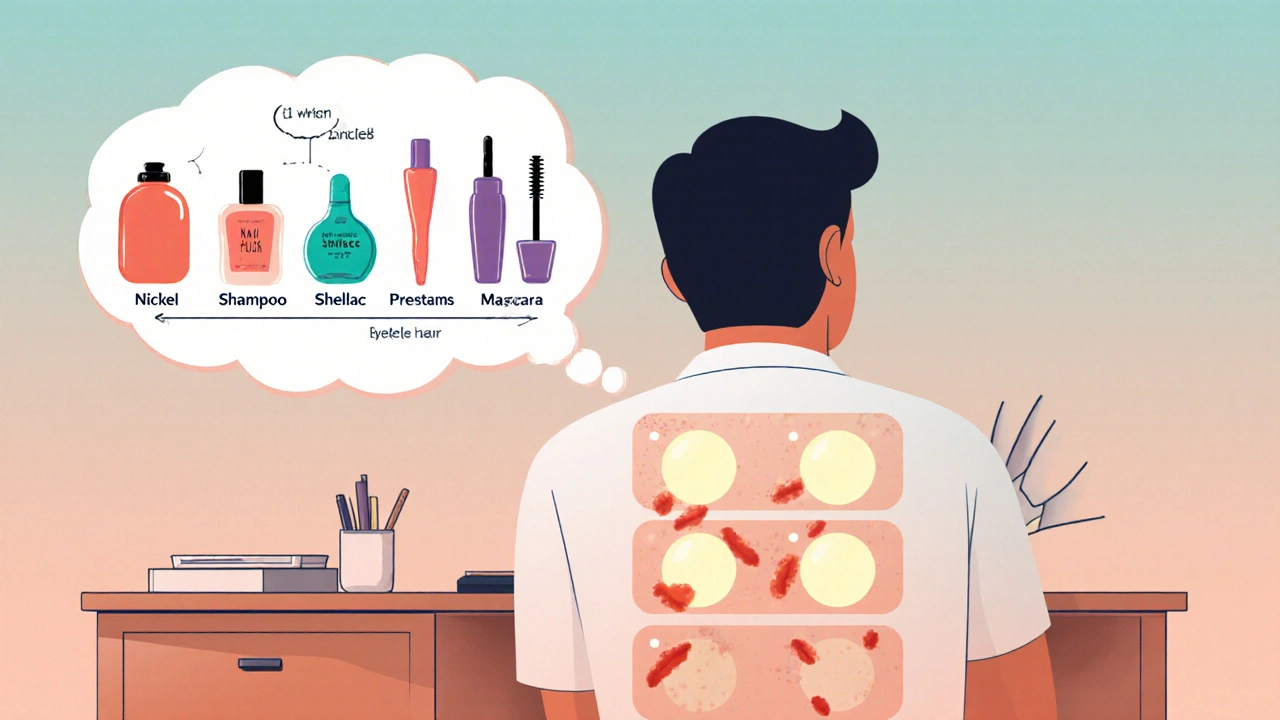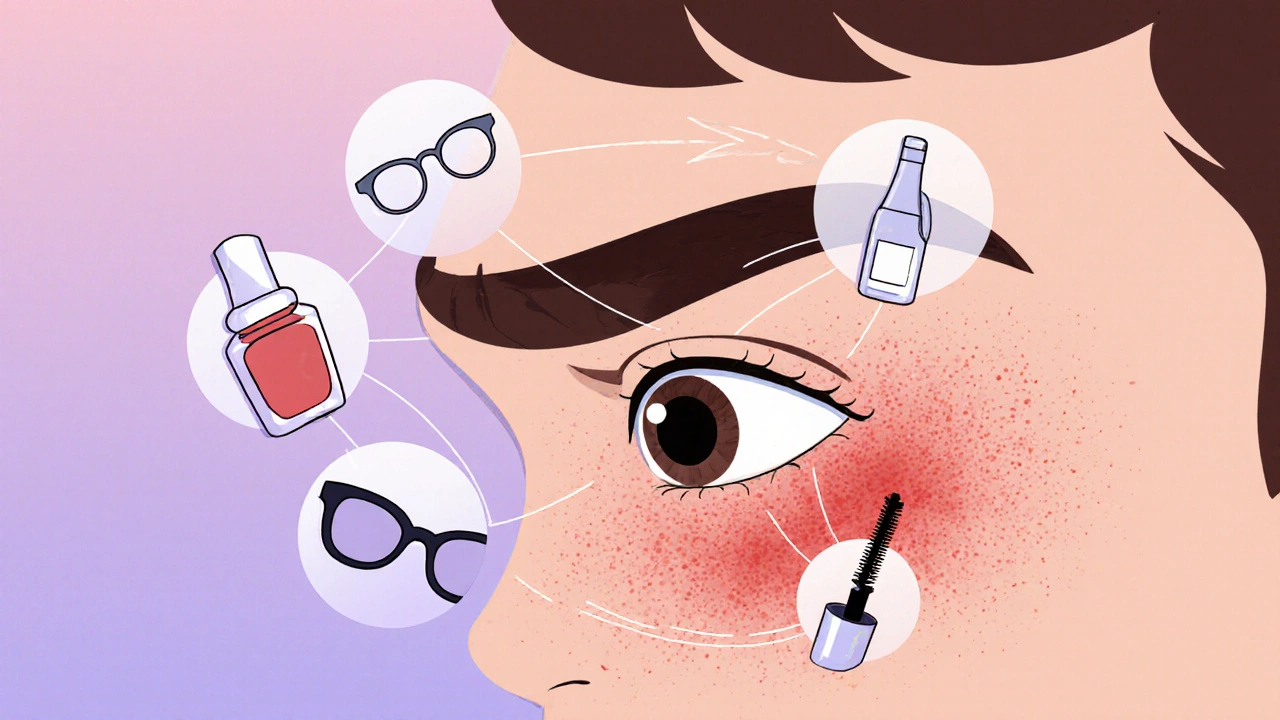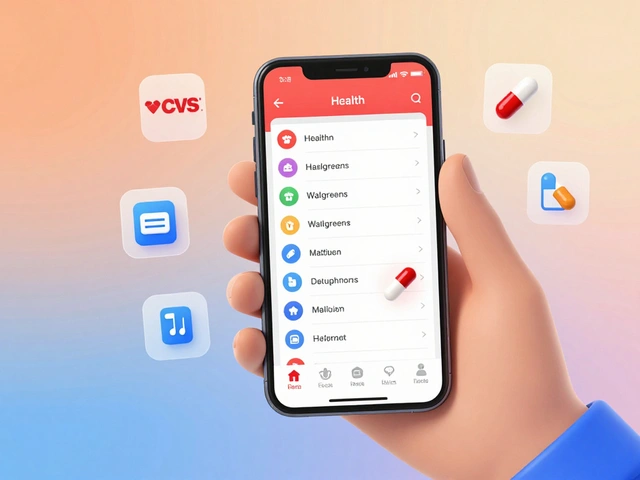The skin around your eyes is the thinnest on your entire body-just 0.55 millimeters thick. That’s why even tiny amounts of everyday products can trigger a painful, itchy reaction known as eyelid dermatitis. If you’ve had red, flaky, swollen eyelids that won’t go away, it’s probably not dryness or stress. It’s likely an allergic reaction to something you’re using regularly-and most people have no idea what it is.
Why Your Eyelids Are So Sensitive
Your eyelids aren’t just delicate. They’re exposed constantly. You rub them when you’re tired. You apply makeup, sunscreen, or eye cream. You touch them after using hand lotion, applying nail polish, or washing your hair. All of that transfers allergens directly to the skin. And because the skin there is so thin, allergens slip through easily and trigger an immune response. This isn’t just irritation. It’s allergic contact dermatitis (ACD), which causes your body to overreact to a specific substance. Symptoms show up 24 to 48 hours after contact, which is why people often blame yesterday’s makeup when the real culprit was last week’s shampoo or last month’s nail polish. A 2023 NIH study found that ACD accounts for 74% of all eyelid dermatitis cases.The Top 7 Allergens You’re Probably Using
Most people assume their eyelid rash comes from eye makeup. But research shows the biggest offenders aren’t always what you put on your lids-they’re what you touch and then transfer.- Nickel (28.7% of cases): Found in cheap jewelry, eyeglass frames, and even magnetic eyelashes. It’s the #1 allergen for eyelid reactions.
- Shellac (21.4%): The gel polish used in nail salons. You don’t apply it to your eyes, but you touch your nails and then your eyelids.
- Preservatives (18.9%): Methylisothiazolinone, parabens, and formaldehyde releasers are in almost every moisturizer, serum, and mascara. Even ‘hypoallergenic’ brands use them.
- Topical antibiotics (15.3%): Neomycin and bacitracin are common in over-the-counter eye ointments and first-aid creams. Many people unknowingly apply these to their eyelids.
- Fragrances (14.6%): Even ‘natural’ fragrances like lavender or tea tree oil can trigger reactions. ‘Fragrance-free’ doesn’t always mean safe-check the INCI label.
- Acrylates (12.1%): Used in long-wear mascaras, waterproof liners, and nail gels. They’re hard to wash off and linger on skin.
- Surfactants (9.8%): Sodium lauryl sulfate and similar detergents in cleansers and shampoos can drip onto your lids during washing.
A 2022 study in the Journal of the American Academy of Dermatology found that 42% of patients didn’t realize their symptoms came from indirect exposure-like nail polish or shampoo. One woman on Reddit spent three years treating her swollen eyelids as ‘dry skin’ until patch testing revealed she was reacting to toluene sulfonamide formaldehyde resin in her nail polish.
Why Patch Testing Is Non-Negotiable
Doctors who aren’t dermatologists often misdiagnose eyelid dermatitis as blepharitis, eczema, or even an infection. They’ll prescribe steroid eye drops or antibiotics, which don’t fix the real problem. The only way to know what’s causing your reaction is patch testing. This isn’t a skin prick test. It’s a slow, careful process where small amounts of 70-100 common allergens are taped to your back for 48 hours. You return in another 24-72 hours to see if any spots react. According to Pure Dermatology’s 2022 protocol, patch testing is 95% accurate when done by a certified dermatologist. The American Academy of Dermatology recommends a full panel that includes not just standard allergens, but also ophthalmic-specific ones like neomycin and preservatives found in eye products. Dr. Erin Warshaw from Wake Forest School of Medicine says, “Clinical history alone correctly identifies triggers in only 37% of cases.” That means if you guess what’s causing it, you’re wrong more than half the time.What Happens If You Use the Wrong Cream
It’s tempting to grab a steroid cream from the cabinet. But eyelid skin is too thin for strong steroids. Using hydrocortisone 2.5% or stronger-even once a day for a week-can cause permanent skin thinning, discoloration, or even raise eye pressure leading to glaucoma. A 2023 warning from Northwestern University’s Dr. Anthony Mancini found that high-potency steroids can cause irreversible atrophy in as few as 7-10 applications on the eyelids. The only FDA-approved steroid specifically for eyelid use is Eysuvis (loteprednol etabonate 0.25%), approved in December 2022. Clinical trials showed 89% of patients saw improvement within two weeks without eye side effects. But even this isn’t for long-term use. For most people, the safest first step is plain petroleum jelly (Vaseline). It’s inert, non-irritating, and creates a barrier to stop allergens from penetrating further. Use it for 1-2 weeks while you wait for patch test results.
How to Actually Get Better (The 3-Phase Protocol)
The American Contact Dermatitis Society recommends a clear, step-by-step plan:- Phase 1 (Days 1-3): Stop everything. No makeup, no eye cream, no facial cleanser. Wash your face with water only. Avoid touching your eyes. Wash your hands frequently.
- Phase 2 (Days 4-14): Soothe and protect. Apply a thin layer of petroleum jelly 2-3 times a day. Use cool compresses for 5 minutes to reduce swelling. Avoid shampoos, conditioners, and hair dyes near your face. Wear gloves when cleaning or applying nail products.
- Phase 3 (Day 15+): Identify and eliminate. Once patch test results come back, remove every product containing the allergen. Use the Contact Allergen Replacement Database (CARD), updated monthly by the University of Louisville, to find safe alternatives. It lists over 12,800 verified products free of 37 common allergens.
A 2022 National Eczema Association survey showed that 68% of patients who followed this exact protocol saw full recovery. Only 32% improved with vague advice like “just stop using makeup.”
Reading Labels That Don’t Tell the Truth
Cosmetic labels are confusing. “Fragrance” on an ingredient list could mean 3,000 different chemicals. “Natural” doesn’t mean safe-botanicals like chamomile, lavender, and yarrow (Compositae family plants) are common allergens. A 2023 JAMA Dermatology study found that 33% of “clean beauty” eye products contained unlisted plant allergens. And “hypoallergenic” is a marketing term with no legal definition in the U.S. Use the Preservative Finder app (downloaded over 147,000 times by Q3 2023). It scans ingredient lists and flags preservatives like methylisothiazolinone, parabens, and formaldehyde releasers. You can also search for “INCI name” on the CARD website to find safe swaps.Who Gets This-and Why It’s Getting Worse
Women make up 78% of cases, with an average age of 34.7. Men account for 22%, averaging 41.2. Why? More frequent use of cosmetics, nail products, and skincare routines. The Global Contact Dermatitis Market reports a 4.7% annual rise in eyelid dermatitis cases since 2018. Why? Cosmetic companies keep adding more preservatives and new ingredients to meet demand for “long-wear,” “waterproof,” and “anti-aging” products. The number of preservatives in cosmetics has increased by 28% in just five years. The EU now requires clearer labeling of fragrance allergens, which the American Academy of Dermatology predicts will cut misdiagnosis by 15-20% in the next three years. But new risks are emerging: magnetic eyelashes contain nickel alloys, and some “biodegradable” mascaras use novel acrylates that haven’t been tested for safety.
What Happens If You Ignore It
Left untreated, eyelid dermatitis can become chronic. The skin thickens, cracks, and scales-a condition called lichenification. You might develop tiny blisters or oozing patches. It can spread to the cheeks, forehead, or neck. Worse, 63% of people with eyelid dermatitis have allergies elsewhere-on their hands, neck, or ears. Your eyelids are often the first warning sign of a broader sensitivity. Ignoring them means you’re missing a chance to stop the problem before it spreads.Real Stories, Real Results
One woman from Melbourne described her 18-month struggle: “I thought it was my eyelash extensions. I switched brands three times. Nothing worked.” After patch testing, she discovered she was reacting to shellac from her weekly gel manicures. Once she stopped getting nails done and switched to a nail polish without it, her eyelids cleared in 10 days. Another man from Perth noticed swelling after using a new face wash. He thought it was his skin getting dry. Patch testing revealed he was allergic to sodium lauryl sulfate. He switched to a sulfate-free cleanser-and within two weeks, his eyelids looked normal for the first time in years.What to Do Next
If your eyelids have been red, itchy, or swollen for more than a week:- Stop all eye makeup, creams, and serums.
- Wash your face with water only.
- Apply petroleum jelly to soothe.
- Book a patch test with a board-certified dermatologist.
- Don’t use steroid creams unless prescribed specifically for eyelids.
- Download the Preservative Finder app and check your current products.
- Visit the CARD database (carddatabase.org) to find safe alternatives.
There’s no magic cure. But there is a clear path: identify the trigger, remove it, and protect your skin. Most people see major improvement within 1-2 weeks. The key isn’t stronger medicine-it’s smarter choices.




Richard Wöhrl on 24 November 2025, AT 09:17 AM
Wow, this is incredibly detailed. I never realized how many hidden allergens are in everyday products-especially shellac from nail polish. I had a persistent eyelid rash for months and assumed it was stress. Patch testing was the only thing that helped. The 3-phase protocol makes total sense. Stop everything, soothe with Vaseline, then systematically eliminate triggers. So many people waste years guessing.